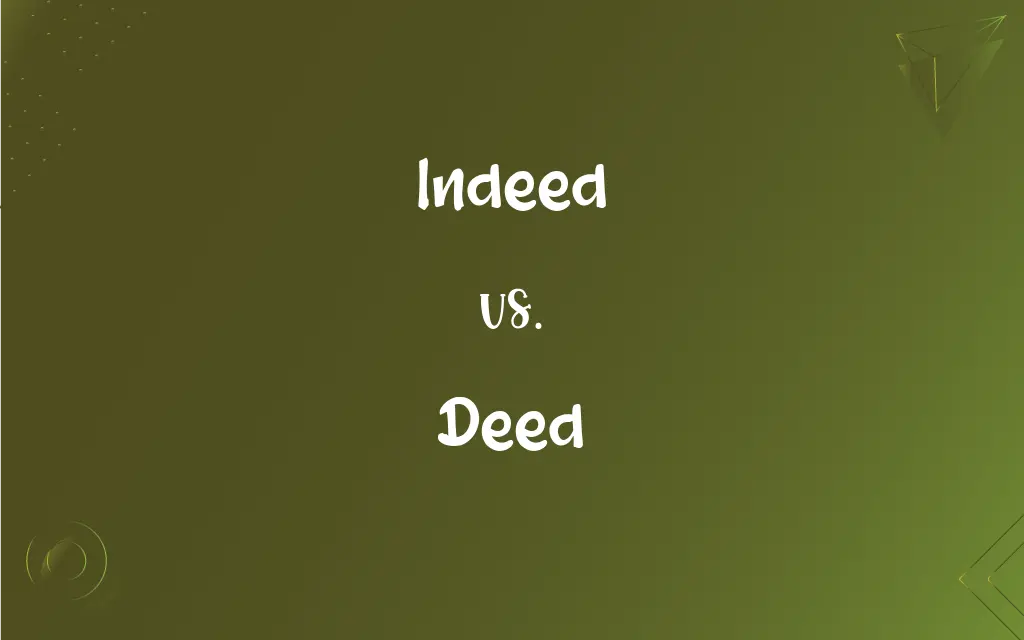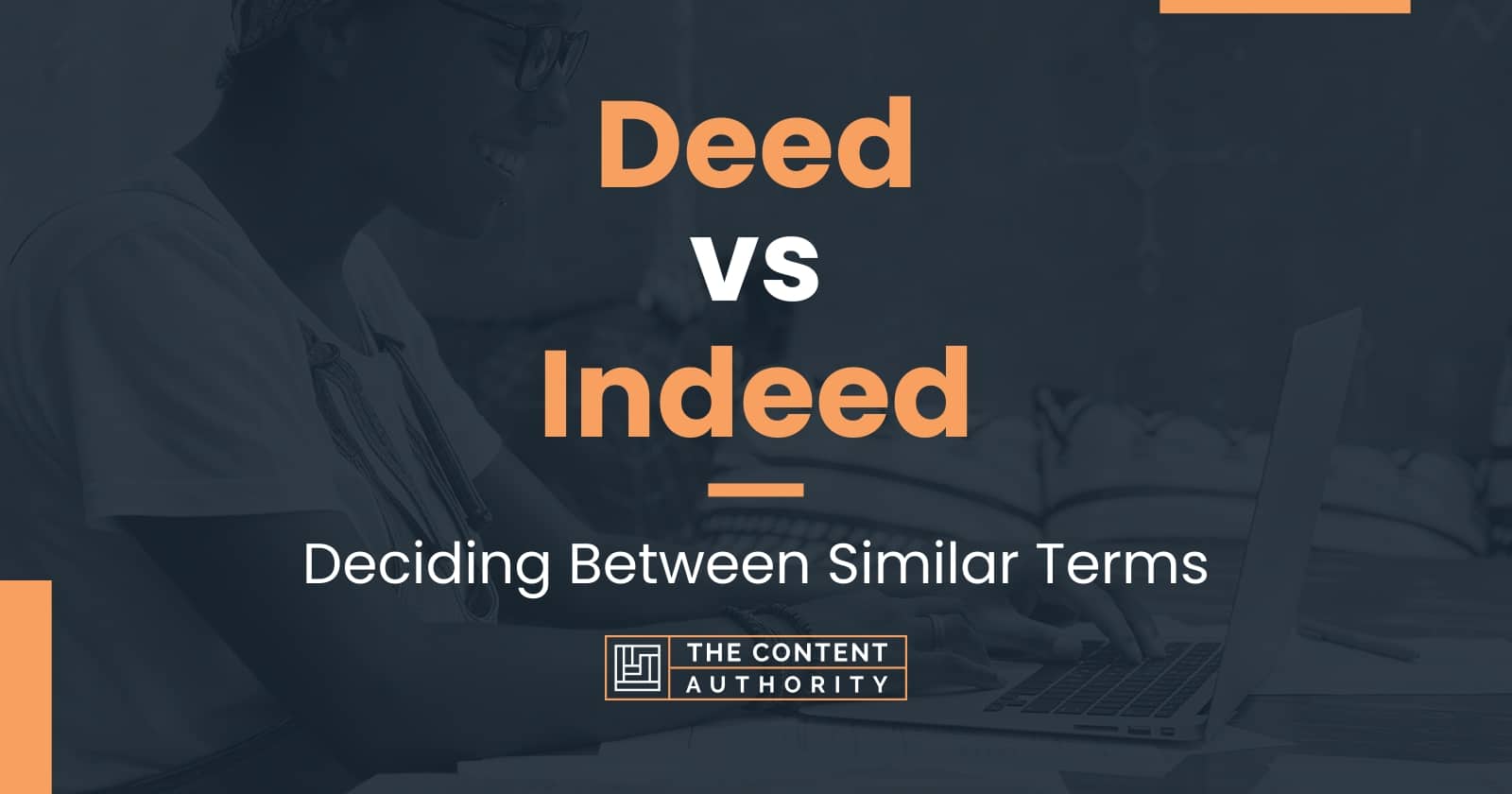Indeed or in deed, these two phrases may seem similar at first glance, but they carry distinct meanings and applications in the English language. Understanding their differences is crucial for improving your grammatical precision and enhancing your communication skills. Whether you're a student, a professional writer, or someone who simply loves the intricacies of language, this article will provide a comprehensive guide to help you master these terms.
In the world of language, precision matters. Indeed or in deed, both phrases have their own unique significance and roles in English grammar. Misusing these terms can lead to confusion and misinterpretation. This article aims to clarify their meanings, origins, and practical applications.
By the end of this article, you'll have a solid understanding of how to use "indeed" and "in deed" correctly in various contexts, ensuring your writing and speech are accurate and effective. Let's dive deeper into the nuances of these terms and uncover their importance in modern English.
Read also:Henry Ford Pain Clinic Your Premier Destination For Comprehensive Pain Management
Understanding Indeed
Indeed is an adverb commonly used in English to emphasize a statement or confirm its truth. It can also serve as a way to introduce a new idea or provide additional information. This versatile word has been part of the English language for centuries, tracing its roots back to Old English.
Origins and Etymology
The word "indeed" originates from the Old English term "on gedēa," which means "in truth" or "in reality." Over time, the word evolved into its current form, maintaining its function as an intensifier in speech and writing.
- Indeed is derived from Old English "on gedēa."
- It emphasizes truth or reality in a statement.
- Its usage has remained consistent throughout the centuries.
Common Usage of Indeed
In modern English, indeed is often used to confirm or reinforce a point. For example, "She is indeed the best candidate for the job." Here, indeed serves to emphasize the speaker's certainty about the candidate's qualifications.
Additionally, indeed can introduce new information, as in "He is not only talented but also indeed very dedicated to his craft." This usage helps bridge ideas and add depth to a conversation or piece of writing.
Exploring In Deed
In deed, on the other hand, is a phrase that refers to actions or actual accomplishments rather than mere words or intentions. It is often used in legal or formal contexts to denote tangible results or performances.
Etymology and Historical Context
The phrase "in deed" comes from the Middle English term "dēd," which means "act" or "action." Over time, it has been used to contrast with "in word," emphasizing the importance of tangible actions over mere promises or statements.
Read also:Understanding Food Stamp Number A Comprehensive Guide To Snap Benefits
- In deed originates from the Middle English "dēd," meaning "act" or "action."
- It is commonly used to highlight the difference between words and actions.
- Legal documents often use "in deed" to refer to formal agreements or contracts.
Practical Applications of In Deed
For instance, in a legal contract, you might see the phrase "in deed" used to refer to the formal document itself, as in "The property was transferred in deed to the new owner." This emphasizes the official nature of the transaction.
Moreover, in everyday language, "in deed" can be used to commend someone for their actions, as in "He talks a lot about helping others, but he truly helps in deed." This highlights the importance of actions over words.
Key Differences Between Indeed and In Deed
While both terms are rooted in the concept of truth and action, they serve different purposes in English. Understanding their distinctions is essential for effective communication.
Grammatical Function
Indeed is an adverb, while in deed is a noun phrase. This fundamental difference affects how they are used in sentences. Indeed modifies verbs, adjectives, or other adverbs, whereas in deed refers to actions or tangible results.
Contextual Usage
In formal or legal settings, in deed is more appropriate when discussing official documents or actions. In contrast, indeed is more commonly used in general conversation or writing to emphasize a point or confirm a statement.
Examples of Indeed and In Deed in Sentences
Let's explore some examples to better understand how indeed and in deed function in various contexts.
Examples of Indeed
- She is indeed a remarkable artist.
- The weather is indeed unpredictable in this region.
- He not only talks about innovation but indeed practices it.
Examples of In Deed
- The agreement was finalized in deed last week.
- He promises a lot, but rarely follows through in deed.
- In word, they support the cause, but in deed, their actions speak louder.
Common Misconceptions About Indeed and In Deed
Many people confuse these two terms due to their similar sounds and meanings. However, understanding their differences can prevent common errors in writing and speech.
Misuse in Writing
One common mistake is using "in deed" when "indeed" is meant, especially in informal writing. For instance, writing "He is in deed very talented" instead of "He is indeed very talented" can confuse readers and undermine the writer's credibility.
Misuse in Speech
In spoken English, the distinction between indeed and in deed may blur due to similar pronunciation. It's important to be mindful of context and choose the appropriate term to convey the intended meaning accurately.
Indeed or In Deed: Which One to Use?
Choosing the right term depends on the context and intended meaning. Here are some guidelines to help you decide:
When to Use Indeed
- Use indeed when you want to emphasize or confirm a statement.
- Choose indeed for general conversation or writing to add weight to your words.
When to Use In Deed
- Use in deed when referring to actions or tangible results.
- Select in deed for legal or formal contexts where official actions are discussed.
Tips for Mastering Indeed and In Deed
Improving your understanding of these terms requires practice and attention to detail. Here are some tips to help you master their usage:
Practice with Sentences
Create sentences using both indeed and in deed to see how they function in different contexts. This exercise will reinforce your understanding and improve your ability to use them correctly.
Read Widely
Expose yourself to a variety of texts, including literature, news articles, and legal documents, to observe how indeed and in deed are used in practice.
Conclusion
Indeed or in deed, both terms are essential components of the English language, each with its own unique role and significance. By understanding their differences and applications, you can enhance your communication skills and avoid common pitfalls in writing and speech.
We encourage you to practice using these terms in your daily conversations and writing. Share your thoughts or questions in the comments below, and don't forget to explore other articles on our site for more insights into the fascinating world of language.
Table of Contents
- Understanding Indeed
- Exploring In Deed
- Key Differences Between Indeed and In Deed
- Examples of Indeed and In Deed in Sentences
- Common Misconceptions About Indeed and In Deed
- Indeed or In Deed: Which One to Use?
- Tips for Mastering Indeed and In Deed
- Conclusion
References:
- Oxford English Dictionary
- Merriam-Webster Dictionary
- Cambridge English Corpus



